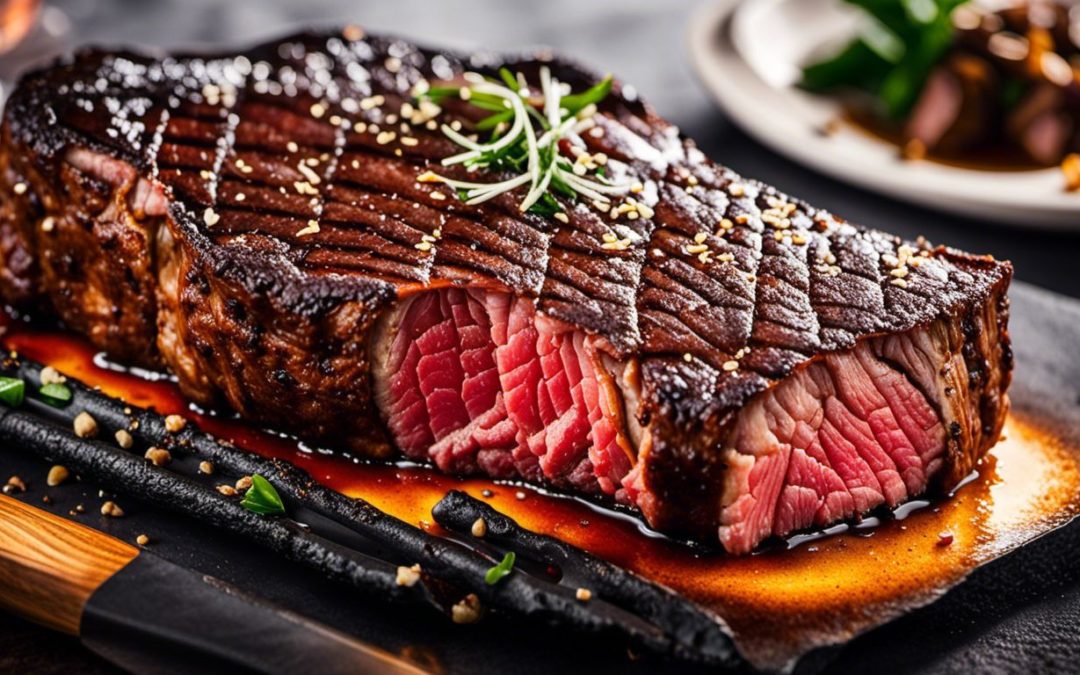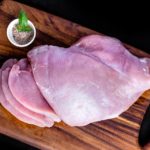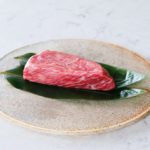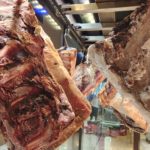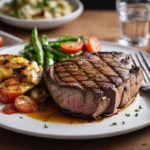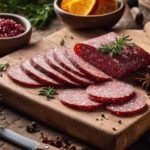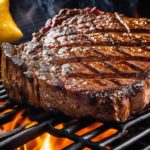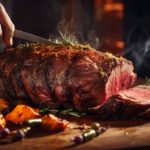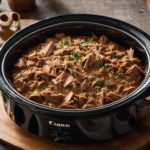Ever wondered why Wagyu beef is all the rage and costs a pretty penny? Like you, we were intrigued by its prevalence in high-end dining and embarked on our own tasteful journey to unearth the secrets of this exclusive delicacy.
This blog unravels everything you need to know about Wagyu; from its origins and distinguishing features to where it can be bought, how best to prepare it, and common misconceptions surrounding it.
Dive right in; let’s embark on this meaty adventure together!
Key Takeaways
- Wagyu beef is a highly prized type of beef known for its exceptional marbling, tenderness, and rich flavor.
- Wagyu originated in Japan and has a storied history dating back to the late 1800s. It is now reared in other countries like Australia and America under specific guidelines.
- Japanese and American Wagyu can be differentiated based on their marbling score, grading system, taste, and texture.
- Wagyu beef has gained immense popularity due to its unique characteristics, perception of luxury, and health benefits.
What is Wagyu Beef?

Wagyu beef is a highly prized and sought-after type of beef known for its exceptional marbling, tenderness, and rich flavor.
Definition and origins
Wagyu is a term that literally translates to ‘Japanese cow.’ It represents four distinct breeds of cattle: the Japanese Black, the Japanese Brown, the Japanese Shorthorn, and the Japanese Polled.
These cows are historically known for their stamina and strength in agriculture, valued traits that inadvertently led to muscular growth with fat marbling unique only to this breed.
The high percentage of marbling is what sets Wagyu beef apart from other types of beef, delivering unmatched tenderness and rich flavors. Originating in Japan centuries ago due to strict breeding methods, this luxurious meat has seen a rise globally with countries like Australia and America now rearing Wagyu cattle under specific guidelines.
The history of Wagyu in Japan
In Japan, Wagyu beef holds a storied history that dates back to the late 1800s. New importation laws allowed European breeds of cattle into the country for crossbreeding, causing the genetic dynamics of Japanese cattle to shift significantly.
Four distinct breeds—Japanese Black, Japanese Brown, Japanese Shorthorn, and Japanese Polled—emerged as genuine ‘Wagyu’, which translates directly to “Japanese Cow”. Over time this breed became prized for its high level of marbling and unrivaled tenderness.
The rearing process evolved into an art of sorts where farmers feed specific diets and give exceptional care to their herds with an intense focus on raising the finest wagyu possible.
This commitment resulted in what we enjoy today —the A5 grade Wagyu steak that boasts unmatched flavor profiles across global culinary realms—from home kitchens to luxury restaurants.
However, this demand has also led some unscrupulous dealers selling counterfeit or mislabeled products under the guise of genuine Wagyu beef.
The rise of Wagyu in the US and other countries
Wagyu beef has made a smashing entry into the culinary scene in America and several other countries. This delectable meat, originally bred and sourced from Japan, began to charm taste buds worldwide owing to its superior marbling and unparalleled flavor.
In recent times, it’s not uncommon to see Wagyu on specialty menus at upscale restaurants or available for purchase from boutique butcher shops.
The fascination with Wagyu extends far beyond the borders of Japan and the United States. Countries like Australia have also made successful attempts at breeding their own versions of this beef.
The Australian Wagyu Association is one such example where continuous efforts are being taken towards producing high-quality domestically raised Wagyu cattle. Despite these international mutations, authentic Japanese wagyu remains a unique delicacy due to its rich history and traditional rearing process.
Differentiating Japanese and American Wagyu

Japanese and American Wagyu can be differentiated based on their marbling score and grading system, as well as differences in taste and texture.
Marbling score and grading system
The marbling score and grading system for Wagyu beef is a critical factor in determining its quality and price. It’s a comprehensive measure that accounts for the degree of marbling, color and brightness of meat, firmness and texture of meat, and color and brightness of fat. Let’s delve into the details.
| Grade | Marbling Score | Description |
|---|---|---|
| A5 | 8-12 | This is the highest quality Wagyu, with very high level of marbling and tenderness, as per our important fact number 7. This grade provides the rich, buttery flavor that Wagyu is renowned for. |
| A4 | 6-8 | Another excellent grade of Wagyu, with high levels of marbling. The taste and texture are still considered exceptional. |
| A3 | 5-6 | This grade has good marbling, but not as much as A5 or A4. However, the taste and texture are still superior to most other beef. |
| A2-A1 | 1-4 | These are the lowest grades for Wagyu. While still considered high-quality beef, they have less marbling and may not offer the same rich flavor and melt-in-your-mouth texture as higher grades. |
Notably, only beef that meets strict criteria can be graded as Wagyu. This includes the breed of the cattle, feeding practices, and handling methods. Understanding the marbling score and grading system is key to appreciating the premium experience that is Wagyu beef.
Differences in taste and texture
Wagyu beef stands out from other types of beef due to its unique taste and texture. When compared to traditional beef, Wagyu has a richer flavor that is often described as buttery and savory.
The high marbling content in Wagyu creates a melt-in-your-mouth sensation that sets it apart. The meat is incredibly tender, making each bite an indulgent experience. The high percentage of monounsaturated fat gives the meat a juiciness that cannot be matched.
With Wagyu, you can expect a truly exceptional dining experience that showcases the finest qualities of premium beef.
Why is Wagyu Beef So Popular?
Wagyu beef has gained immense popularity due to its unique characteristics, perception of luxury, and health benefits.
The unique characteristics of Wagyu
Wagyu beef stands out from other types of beef due to its unique characteristics. One distinguishing feature is the high level of marbling, which refers to the intramuscular fat that gives the meat its rich flavor and tender texture.
This high marbling sets Wagyu apart and contributes to its reputation as one of the most sought-after meats in the world. Another remarkable quality of Wagyu is its exceptional taste profile.
The meat has a distinct buttery flavor that melts in your mouth, leaving a delightful umami sensation on your palate. Additionally, Wagyu beef is known for being incredibly juicy and succulent, making each bite a true culinary delight.
The perception of luxury and exclusivity
Wagyu beef holds a special place in the culinary world, often associated with luxury and exclusivity. Its reputation as the most sought-after beef comes from its exceptional quality and unique characteristics.
With its high marbling and melt-in-your-mouth texture, Wagyu beef offers an unparalleled dining experience that is truly indulgent. Due to its limited availability and meticulous rearing process, Wagyu has become synonymous with opulence, making it a coveted choice for those seeking a truly premium steak.
Health benefits of Wagyu
Wagyu beef not only offers a superb dining experience, but it also comes with some impressive health benefits. One of the standout features of Wagyu is its high percentage of monounsaturated fat.
Unlike saturated fats found in other meats, this type of fat has been linked to heart health and can help lower bad cholesterol levels. Additionally, Wagyu beef is packed with essential fatty acids like omega-3 and omega-6, which are important for brain function and reducing inflammation in the body.
With these nutritional advantages, enjoying a delicious Wagyu steak can be both satisfying and good for your overall well-being.
What Does Wagyu Beef Taste Like?
Wagyu beef is known for its rich, buttery flavor and melt-in-your-mouth texture that meat lovers can’t resist. Discover the incredible taste of this premium beef and learn why it’s a favorite among food enthusiasts.
Ready to indulge your taste buds? Read on!
The rich, buttery flavor
When it comes to the taste of Wagyu beef, one word can describe it perfectly: rich. The flavor of Wagyu is like no other – it is a symphony of buttery goodness that melts in your mouth with each bite.
This unique richness comes from the high level of marbling found in Wagyu beef, which is the beautiful veins of fat that run through the meat. As you cook Wagyu, this marbling melts and infuses every fiber with its luxurious flavor, creating a truly unforgettable dining experience.
Whether you grill it, sear it, or roast it, be prepared for a culinary delight like no other – a tender texture and an explosion of savory notes that will leave your taste buds begging for more.
The tender, melt-in-your-mouth texture
Wagyu beef is renowned for its tender, melt-in-your-mouth texture that sets it apart from other types of meat. The high level of marbling in Wagyu beef results in a buttery smoothness that practically dissolves on your tongue with each bite.
This exquisite texture is achieved through the unique breeding and rearing methods used for Wagyu cattle, which involves careful diet and treatment to ensure maximum tenderness. Whether pan-seared, grilled, or cooked sous vide, Wagyu beef promises an indulgent dining experience like no other.
Umami and other flavor profiles
Wagyu beef is not only prized for its tenderness and juiciness, but it also offers a unique flavor profile that sets it apart from other types of beef. One prominent flavor characteristic of Wagyu beef is umami, which can be described as a savory and meaty taste.
This rich umami flavor is due to the high level of marbling and intramuscular fat in Wagyu beef. It gives each bite a depth and complexity that meat lovers truly appreciate. In addition to umami, Wagyu beef may also have notes of sweetness and nuttiness, making it an indulgent sensory experience.
Whether enjoyed in steak form or used in culinary creations, the distinct flavor profile of Wagyu beef is sure to leave a lasting impression on your taste buds.
How to Cook Wagyu Beef
Cooking Wagyu beef requires special attention to ensure that you bring out its rich flavors and maintain its tender texture.
Tips for cooking Wagyu to perfection
Cooking Wagyu beef to perfection requires some special techniques and attention to detail. Here are some tips to help you bring out the amazing flavors and textures of this exquisite meat:
- Start with room temperature meat: Bring the Wagyu beef to room temperature before cooking. This allows for even cooking and ensures a juicy, tender result.
- Season sparingly: Wagyu beef is already packed with flavor, so keep the seasoning simple. A sprinkle of salt and pepper is often all you need to enhance the natural richness of the meat.
- Preheat your cooking surface: Whether grilling or searing on a stovetop, make sure your cooking surface is hot before adding the Wagyu beef. This will help create a delicious caramelized crust while keeping the inside tender.
- Use high heat for short cooking times: Cook your Wagyu beef quickly over high heat to preserve its tenderness and prevent it from becoming tough. Aim for medium-rare to medium doneness for the best balance of flavors.
- Let it rest: After cooking, allow your Wagyu beef to rest for a few minutes before slicing or serving. This allows the juices to redistribute throughout the meat, resulting in a more succulent eating experience.
- Slice against the grain: When cutting your cooked Wagyu beef, be sure to slice against the grain for maximum tenderness. This will help break up any muscle fibers and make each bite melt in your mouth.
- Experiment with different preparations: While simplicity often lets the natural flavors shine through, don’t be afraid to get creative with your seasonings or marinades if you’re feeling adventurous.
Recommended cooking methods
When cooking Wagyu beef, it’s important to use methods that will enhance its incredible flavor and tenderness. Here are some recommended cooking methods for enjoying your Wagyu steak:
- Searing: Start by searing the steak on high heat to create a flavorful crust while locking in the juices. Use a cast-iron skillet or grill pan for best results.
- Sous Vide: For precise temperature control and ultimate tenderness, try cooking your Wagyu steak using the sous vide method. Vacuum-seal the steak with your favorite seasonings and cook it in a water bath at a low temperature for an extended period of time.
- Reverse Searing: This method involves slow-cooking the steak at a low temperature first, then finishing it off with a quick sear to achieve a perfect medium-rare or medium doneness.
- Grilling: For those who love the smoky flavors of outdoor cooking, grilling is an excellent option for cooking Wagyu beef. Use direct heat to sear both sides of the steak, then move it to indirect heat to finish cooking slowly.
- Broiling: If you prefer indoor cooking, broiling is a great way to achieve that delicious caramelized crust on your Wagyu steak. Place the steak on a broiler pan and cook it under high heat until desired doneness.
Pairing suggestions and flavor enhancers
When it comes to enjoying the rich and buttery flavor of Wagyu beef, there are a variety of pairing suggestions and flavor enhancers that can complement its unique taste. Here are some ideas to enhance your Wagyu dining experience:
- Wine Pairings: Opt for full-bodied red wines such as Cabernet Sauvignon or Merlot to match the intensity of Wagyu beef. The tannins in these wines help cut through the richness of the meat, creating a balanced combination.
- Whiskey or Bourbon: If you prefer spirits, consider enjoying your Wagyu beef with a glass of whiskey or bourbon. The smoky and caramel notes in these spirits can complement the flavors of the beef.
- Truffle Butter: Elevate the indulgence factor by adding a dollop of truffle butter to your cooked Wagyu steak. The earthy and luxurious flavor of truffles pairs beautifully with the rich taste of Wagyu.
- Sea Salt: Enhance the natural flavors of Wagyu by seasoning it with a sprinkle of high-quality sea salt. This simple but effective addition brings out the meat’s inherent savory qualities.
- Grilled Vegetables: Serve grilled vegetables alongside your Wagyu steak to add some freshness and balance to your meal. Asparagus, mushrooms, and zucchini make excellent accompaniments that provide a contrast in texture and flavor.
- Chimichurri Sauce: For those who enjoy bold flavors, consider drizzling your Wagyu steak with chimichurri sauce. Made from herbs, garlic, vinegar, and oil, this tangy sauce can provide a vibrant contrast to the richness of the meat.
- Japanese Ponzu Sauce: If you want to highlight the umami flavors present in both Japanese Wagyu beef and ponzu sauce, try combining them together. Ponzu sauce is made from citrus juice, soy sauce, vinegar, and dashi stock – creating a citrusy and savory combination that complements Wagyu well.
- Gourmet Mustards: Experiment with different gourmet mustards to add a tangy kick to your Wagyu steak. Whole grain or Dijon mustard can provide a subtle heat and additional layers of flavor.
The Assortment of Wagyu Steak Cuts
From ribeye to filet mignon, discover the mouthwatering profiles and flavors of different Wagyu cuts that will leave you craving for more.
Profiles and flavors of different Wagyu cuts
Wagyu beef offers a variety of delicious cuts, each with its own unique flavor profile. One popular cut is the ribeye, known for its rich marbling and tender texture. It’s perfect for grilling or searing to bring out its juicy flavors.
Another mouthwatering option is the striploin, which boasts a buttery taste and melt-in-your-mouth tenderness. It can be cooked in various ways, from pan-frying to broiling. For those who prefer a leaner cut, the tenderloin is an excellent choice.
Although it has less marbling than other cuts, it still delivers exceptional flavor and tenderness. Other notable Wagyu cuts include the flank steak, sirloin steak, and brisket – all offering their own distinct characteristics that will satisfy any meat lover’s palate.
But let’s not forget about the delectable Wagyu burgers! Made from ground Wagyu beef, these patties are incredibly flavorful and juicy when cooked just right. Whether you’re grilling them at a backyard barbecue or making gourmet sliders in your kitchen, Wagyu burgers are sure to impress.
Popular choices and recommended cooking techniques for each cut
When it comes to cooking Wagyu beef, each cut has its own unique qualities and recommended cooking techniques. Here are some popular choices and tips for preparing them:
- Ribeye: This well-marbled cut is perfect for grilling or searing. Cook it on high heat to get a beautiful crust while keeping the inside juicy and tender.
- Tenderloin: Also known as filet mignon, this lean cut is incredibly tender. It’s best cooked using dry heat methods like grilling or pan-searing. Keep it medium-rare to enjoy its natural flavors.
- Striploin: With a balance of marbling and tenderness, the striploin is great for grilling or broiling. Cook it to medium-rare or medium for a melt-in-your-mouth texture.
- Flat Iron: This flavorful cut is best cooked using dry heat methods like grilling or pan-frying. It’s also great for marinating before cooking to enhance its taste.
- Skirt Steak: Known for its rich flavor, the skirt steak is perfect for grilling or smoking. Cook it quickly over high heat and slice against the grain to maximize tenderness.
- Chuck Roast: This versatile cut is ideal for slow cooking methods like braising or roasting. The long cooking time allows the meat to become tender and juicy.
- Short Ribs: These meaty ribs are perfect for slow cooking methods like braising or barbecuing. The low and slow process helps break down the connective tissues, resulting in incredibly tender meat.
- Brisket: Best known for making mouthwatering barbecued beef, brisket requires long hours of smoking at a low temperature to achieve that signature smoky flavor and fork-tender texture.
Wagyu Beef Misconceptions and Scams
Don’t fall for the Kobe confusion or misleading labeling when it comes to wagyu beef. Learn how to ensure authenticity and quality in your wagyu purchases. Read on for tips and tricks to avoid scams and enjoy the true taste of this premium meat.
The Kobe confusion and misleading labeling
The Kobe confusion and misleading labeling surrounding Wagyu beef can be quite perplexing for meat lovers. Many people mistakenly believe that all Wagyu beef is the same as Kobe beef, when in fact, this is not the case.
Kobe beef comes specifically from a region in Japan and must meet strict criteria to earn the prestigious name. However, there are other types of high-quality Wagyu beef available, such as American or Australian Wagyu.
Another issue is misleading labeling. Some products may claim to be “Kobe-style” or use similar terms to make consumers think they are purchasing authentic Kobe beef when they are not.
It’s important to read labels carefully and do your research before buying Wagyu beef to ensure you’re getting what you pay for.
Ensuring authenticity and quality when purchasing Wagyu
When purchasing Wagyu beef, it is important to ensure its authenticity and quality. With the high demand for this luxurious meat, there are instances of counterfeit or mislabeled products in the market.
To avoid falling victim to scams, here are a few tips to keep in mind. First, look for reputable sellers who specialize in selling authentic Wagyu beef. Trusted online retailers and specialty butcher shops often have stringent quality control measures in place.
Additionally, consider buying directly from Wagyu farms and producers who can provide information about their rearing processes and certifications. Lastly, familiarize yourself with the grading system for Wagyu beef – A5 being the highest grade – so you can make an informed decision when making a purchase.
Conclusion
In conclusion, this ultimate guide has provided you with everything you need to know about Wagyu beef. From its origins in Japan to its rise in popularity worldwide, we’ve explored the unique characteristics and flavors that make it a delicacy.
We’ve also covered how to cook and where to buy Wagyu beef, as well as common misconceptions and scams to watch out for. Now armed with knowledge about this luxurious meat, you can indulge in the rich taste and melt-in-your-mouth texture of Wagyu beef with confidence.
FAQs
What is Wagyu beef and what sets it apart from other types of beef?
Wagyu beef is a highly prized type of beef originating from Japan. It is known for its exceptional marbling, resulting in a tender texture and rich flavor that sets it apart from other types of beef.
How can I tell if the Wagyu beef I am purchasing is authentic?
To ensure you are purchasing authentic Wagyu beef, look for certifications and labels indicating its origin, such as “Japanese Wagyu” or “Kobe Beef.” Additionally, reputable vendors will provide detailed information about the breed, feeding methods, and grading system used.
How should I cook Wagyu beef to bring out its best flavors?
Wagyu beef is best cooked using gentle heat to preserve its delicate marbling and tenderness. This can be achieved through methods such as searing on high heat briefly or cooking at low temperatures for extended periods. It is also recommended to avoid over-seasoning or overwhelming the natural flavors of the meat.
Can I substitute other types of beef for Wagyu in recipes?
While you can certainly substitute other types of beef in recipes calling for Wagyu, keep in mind that the unique qualities of Wagyu may not be replicated completely. The rich marbling and melt-in-your-mouth texture are distinct characteristics that contribute to the overall taste experience of dishes featuring this premium meat.
What is wagyu beef?
A: Wagyu beef is a type of high-quality beef that originates from Japan. It is known for its exceptional marbling and tenderness, which is a result of the unique breeding and feeding techniques used for wagyu cattle.
What is the difference between wagyu and kobe beef?
A: Kobe beef is a specific type of wagyu beef that comes from the Tajima strain of wagyu cattle, raised in the Hyogo Prefecture in Japan. While all Kobe beef is wagyu, not all wagyu beef is Kobe beef.
What breeds are used to produce wagyu beef?
A: Wagyu beef is produced from several different breeds of cattle, including the Tajima, Shimane, and Kedaka breeds. These breeds are selected for their ability to develop a high degree of marbling.
What is the grading system for wagyu beef?
A: The grading system for wagyu beef is based on the yield grade and beef marbling score. The yield grade represents the amount of usable meat obtained from a carcass, while the beef marbling score indicates the level of marbling present in the meat.
Can wagyu beef be found outside of Japan?
A: Yes, wagyu beef can be found outside of Japan. There are now farms in other countries, such as Australia and the United States, that raise wagyu cattle and produce wagyu beef.
What is the history of wagyu beef?
A: Wagyu beef has a long history that dates back several centuries in Japan. The breed was originally used as work animals in agriculture and was not consumed as meat until later on. It was during the 20th century that wagyu beef gained recognition for its exceptional flavor and tenderness.
What makes wagyu beef different from other types of beef?
A: Wagyu beef is known for its high degree of marbling, which is the intramuscular fat that gives the meat its characteristic flavor and tenderness. It also has a unique texture and is often described as buttery or melt-in-your-mouth.
How is wagyu beef produced?
A: Wagyu beef is produced through careful breeding and feeding techniques. Wagyu cattle are typically raised in a stress-free environment and fed a specific diet that includes high-quality grains. This helps to promote the development of marbling in the meat.
Can wagyu beef be crossbred with other breeds?
A: Yes, wagyu beef can be crossbred with other breeds to produce crossbred wagyu cattle. However, the resulting meat may not have the same level of marbling and tenderness as purebred wagyu beef.
Is wagyu beef healthier than other types of beef?
A: Wagyu beef tends to have a higher percentage of monounsaturated fats compared to other types of beef. These fats are considered to be healthier for the body and can have potential health benefits when consumed in moderation.
Greetings!
With over two decades of diverse experience in the meat industry, I proudly stand as an expert in all things meat. My journey commenced with a strong foundation in hospitality, where I honed my culinary skills as a chef in prestigious restaurants and on luxurious superyachts worldwide.
However, my true passion lies in the art of butchery. Throughout my extensive career, I have had the privilege of working with renowned meat purveyors and mastering the craft of meat cutting and preparation. From breaking down whole carcasses to meticulously selecting prime cuts, my butchery expertise is at the core of my meat knowledge.
Having immersed myself in various cultures and cuisines, I have honed my skills to deliver exceptional dining experiences, crafting delectable dishes that celebrate the natural flavors of different meats. Whether it's sourcing the finest meats for discerning clients or sharing valuable tips on meat selection and cooking, I take pride in elevating the meat experience for both professionals and enthusiasts.
My journey has taken me from the bustling kitchens of top-rated restaurants to the heart of meat processing facilities, gaining insights and honing my skills to become a true meat connoisseur. Now, I am enthusiastic about sharing my expertise, offering valuable insights on meat selection, cooking techniques, and the art of butchery.

